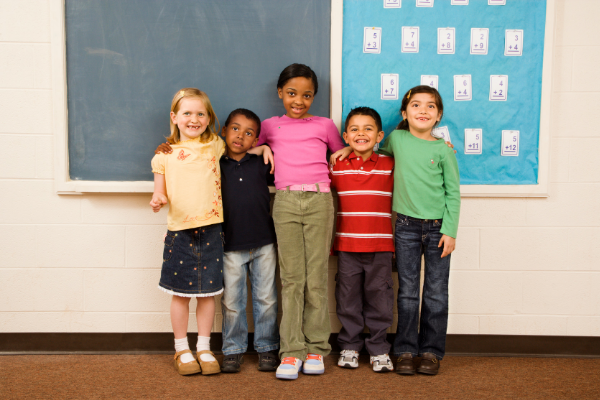
We were standing in line at a store when my inquisitive 3-year old stared directly at the woman behind us and loudly asked, “Mommy why does her hair look like that?” By “like that” he meant that it was much darker than his hair, much coarser, and woven together in thick braids. Thankfully, the black woman he was speaking about returned his question with a kind smile as I knelt down next to him to offer an answer. “Her hair looks different than ours, doesn’t it? Isn’t it pretty the way it’s all braided together like that? It’s kind of cool that people are different and our hair and bodies sometimes look different, too.” Looking back, I’m happy with the response I culled together in that split second, though at the time I remember feeling red hot with embarrassment and a bit worried that my son may have upset the woman in the store with his very frank, loud question.
I’ve always tried to be honest, open, and factual when explaining things to my kids, but on the few occasions when race has come up, I’ve been unprepared and caught off guard, feeling like a fish out of water when trying to figure out how to broach this topic.
This is why I found Dr. Micia Mosely’s recent “How to Talk to Kids About Race” session so valuable.
Dr. Mosely is a well-known figure in San Francisco’s educational community. Last month was the first I’d met her, even knew of her, and after just a few hours together, she left quite a lasting impression on me, and undoubtedly many of the others who also attended her evening session.
As I sat in a room with about 75 other parents and educators, I realized how lucky I was to be here, having this conversation, and raising my boys in a city that both has a diverse population, and people who are willing to talk openly about our differences. Living in the Bay Area we have an opportunity, almost a privilege, to learn about these topics in a way that not everyone in the US has. Even Dr. Mosely admitted to having given prior talks in other cities in which she could not be as open and forthright in how she covered these delicate topics. But when we met a few weeks ago, she tackled them head-on and invited us all to do the same.
Setting the stage for race talks
Our discussion (and I call it a discussion rather than a seminar because it was highly interactive; the attendees were equally a part of the evening’s conversation) began with the definitions of a few key terms:
Race
A historically shifting, socially constructed human classification system to establish power by grouping people primarily by physical appearance or markers. Race designations rely primarily on generalized conceptions of physical appearance (e.g. skin tone) or in certain cases, ancestry, history, and language, in order to advantage a dominant group and disadvantage others.
Ethnicity
Cultural identification of a group or individual that typically varies by geographic origin and manifests itself in similar language, customs, art, food, history, religion, etc.
Racism
Racial prejudice combined with systemic power. This manifests on ideological, institutional, interpersonal and intrapersonal levels.
By way of example, someone could be black (race) and French (ethnicity) or white (race) and Polish (ethnicity).
It is important to begin with some introspective work, and a bit of historical education, Dr. Mosely feels, because we can’t talk to our children about race until we are comfortable with the topics ourselves. “You know what they say every time you get on an airplane, ‘Put the mask on yourself before assisting others.’ You have to understand yourself before you help guide your children.”
As is the case with many difficult discussions in life, you also have to practice. “If you want to talk to kids about race,” she said, “you have to practice talking about it.”
These two concepts are so simple, almost obvious, but I had completely overlooked them in my attempts to have these conversations with my son. If you read nothing else, let me re-emphasize:
-
Seek to understand yourself, then help guide your children in their understanding of race.
-
Be prepared for race conversations. Practice!
Jay Smooth gives a terrific, brief TEDx talk titled “How I Learned to Stop Worrying and Love Discussing Race.” In it, he says that “Race is a social contract that was not designed to make sense. It was designed to rationalize and justify unjustifiable acts.” He describes the prejudice that, to some degree, lives within each of us. He encourages us to be cognizant of it and to regularly take an honest look in the mirror, evaluating our own biases and how we can shift our minds and our actions to be more in line with where we hope for them to be. He says, “Prejudice is something we all have to work on continually. It’s not binary; you don’t get your prejudice removed like you do your tonsils. It’s like plaque on your teeth; it builds up every day, and you have to regularly attend to it.”
So, how DO we talk to kids about race?
The same way we talk to them about everything else. Trying to craft the perfect conversation, according to Dr. Mosely, is not the way to go. Rather, think of it as an iterative conversation, one that is ongoing, constant. She also recommends integrating the topic into other topics that we discuss on a daily basis: respect, listening, personal space, our bodies, etc.
She advises parents to connect the conversations back to empathy. For example, if my son doesn’t want to play with someone who looks different than himself, rather than scolding him and telling him “don’t be racist!” I would connect back to empathy with “Wow, a comment like that could really hurt his feelings. I wonder how it makes him feel when he hears you say that you don’t want to play with him.” However, also bear in mind that kids may react to a situation they’re still trying to process with a comment like, “I don’t want to play with that child,” when what they’re really experiencing is, “This is new and different for me; I’m uncomfortable and I don’t know what to do.” Be direct, patient, and supportive as children notice differences and seek to understand them. They may not have the right words or know the right actions to take in these situations; this is where our guidance is so critical.
To summarize some of Dr. Mosely’s top tips for having conversations with kids about race:
- Get comfortable with the topic first. Kids will sense right away if we’re uncomfortable.
- How do we get comfortable? Be knowledgeable and ensure we have racial diversity in our own lives. Read, befriend those of a different race, ask questions.
- Demonstrate empathy.
- Don’t “shhh” children when they notice differences. Teaching kids to be color blind is harmful, not helpful. Don’t silence the reality they are experiencing. Rather, embrace these moments as learning opportunities.
- Instill in children a sense that we have the opportunity to make inequality better. As citizens of San Francisco, of the world, even the tiniest of people can make a difference.
Learn more about Dr. Mosely and Black Teacher Project, an organization she founded, at https://miciamosely.com/education-final/.















